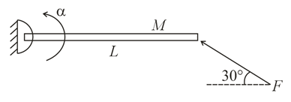Embibe Experts Solutions for Exercise 1: EXERCISE
Embibe Experts Physics Solutions for Exercise - Embibe Experts Solutions for Exercise 1: EXERCISE
Attempt the practice questions from Exercise 1: EXERCISE with hints and solutions to strengthen your understanding. Gamma Question Bank for Medical Physics solutions are prepared by Experienced Embibe Experts.
Questions from Embibe Experts Solutions for Exercise 1: EXERCISE with Hints & Solutions
A thin uniform circular ring is rolling down an inclined plane of inclination without slipping. Its linear acceleration along the inclined plane is
A cylinder of radius and mass rolls without slipping down a plane inclined at an angle . Coefficient of friction between the cylinder and the plane is . For what maximum-inclination will the cylinder roll without slipping?
A physical balance has its arms of unequal length. A body weighs if kept in one pan and weighs if kept in the other pan. The true weight of the body is
A solid cylinder and a solid sphere of same mass and radius roll without slipping on a rough inclined plane. The force of friction is
A solid sphere is thrown up a rough incline. The sphere rolls up without slipping and eventually comes down rolling without slipping. The direction of static friction in upward and downward motion respectively is
Two solid spheres of different mass, radii and density roll down a rough inclined plane under identical situation. Their time to come down is independent of their
A thin circular ring first slips down a smooth incline then rolls down a rough incline of identical geometry from same height. Ratio of time taken in the two motion is
The thin rod shown below has mass and length . A force acts at one end as shown and the rod is free to rotate about the other end in the plane of force. Initial angular acceleration of the rod is

